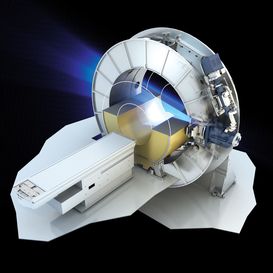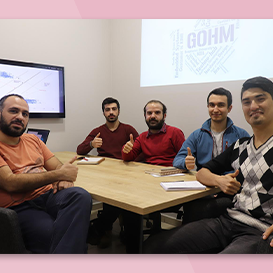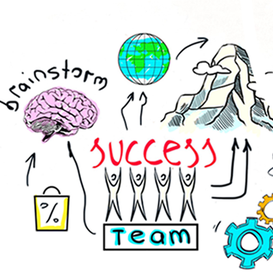Focus on Canada
Connecting companies to enable access to new markets and global value chains
Jiang Chen, the Canadian ITEA Public Authority representative modestly refers to himself as one of over 255 Industrial Technology Advisors at the National Research Council of Canada Industrial Research Assistance Program (NRC IRAP). It is from here that Canadian companies, chiefly SMEs, can gain access to both advice and funding to develop innovative, technology-driven new or improved products, services or processes in Canada and beyond. It also houses and manages Canada's Eureka National Office and provides companies with a first contact point in Canada for Eureka's global network, including ITEA. Back in 2017, when the ITEA Magazine also had a focus on Canada, the article referred to SMEs in Canada as “the backbone of the economy, so there’s a great emphasis on SME support.”
Diverse, innovative and growing
And this comment then is equally applicable today, if not more. “SMEs contribute over 50% to the GDP in Canada and are responsible for over 80% of the workforce. They are prominent in the ICT sector which, according to Statistics Canada, had a GDP of 94.1 billion Canadian dollars and accounted for 4.8% of the national GDP. In fact, since 2013 onward, the ICT sector has consistently outperformed the overall economy and, in 2019, grew at over triple the rate of the total Canadian economy.” These impressive figures are led by the software and computer services sub-sector in which 39,000 of the more than 43,200 companies operate in the Canadian ICT sector. Jiang calls Canada’s ICT sector “diverse, innovative and a growing segment of the overall economy where the latest innovative technologies, such as Artificial Intelligence (AI), Big Data, 5G and Blockchain, are fuelling growth in the sector itself and in the overall economy. If we talk about R&D,” Jiang continues, “you will see that ICT industries are the fastest growing in the Canadian private sector. In 2019, the sector held a 41.2% share of all private sector R&D expenditure in Canada, with the largest increase in R&D spending coming in the area of software and computer services (+11.7%). ICT is also responsible for employing 10.7% of the total workforce in Canada – that’s 1.7 million people. The ICT sector is characterised by a knowledge-intensive workforce, with over half of its workers holding a university degree, compared to 30.5% within Canadian industries as a whole. So it’s evident that ICT and software-intensive services play a critical role in the economy and society of Canada today.”
Innovation – ready for the future
As a world leader in science, technology and innovation, Canada is recognised as one of the most innovative and competitive economies in the world. “Canadian companies are very competitive and have a leading edge in many areas, especially when it comes to our national priorities in respect of software innovation, such as Artificial Intelligence, Internet of Things, Cybersecurity, Automation, SaaS and Cloud computing, and Mobile Usage and 5G. In the Government of Canada’s Budget for 2017, the role of innovation in the future of and for its citizens was underlined as the document stated that ‘innovation is what allows Canadians to adapt to change and prepare for the future’.” One of the mechanisms for translating this innovation into tangible results and impact is a multi-year Innovation and Skills Plan rooted in four interconnected and mutually reinforcing pillars (see red box.
Top tech talent hubs
Large industries, SMEs, academic institutions and research and technology organisations are integral parts of Canada’s innovation ecosystem. There are numerous governmental and private programmes that support innovation in Canada. And these efforts are clearly paying off. The Annual Developer Survey revealed that Canada accounted for 2.98% of the developers in 2019, making Canada the sixth most represented in terms of developer talent globally. Canada also holds a similar ranking as one of the largest cybersecurity innovation hubs in the world according to venture capital deals (2016-2019). Through its National Cyber Security Strategy, Canada is committed to investing 507 million Canadian dollars over a five-year period. Toronto (#3), Vancouver (#12), Montreal (#13) and Ottawa (#19) are ranked in the CBRE’s top 20 tech talent markets in North America. “To take one software development industry example,” Jiang says, “every gamer knows or plays FIFA 19, Assassin’s Creed Odyssey or Shadow of the Tomb Raider. Well, these bestselling games were all developed in Canada.” In 2017, video game production contributed 4.5 billion dollars to Canada’s GDP and accounted for over 48,000 jobs. The growth rate for the video games industry was 20% between 2017 and 2019. There were 692 gaming studios and 71 investment announcements, between 2015 and 2019. Canada has the third largest video game development and production hub in the world.
Innovation and Skills Plan
- People and Skills – Ensuring businesses have the right pipeline of talent to succeed and equipping Canadians with the tools, skills, and experience they need to succeed throughout their lifetimes.
- Building Ecosystems – Science, Technology, and Superclusters – Building innovation ecosystems through new partnerships, bridging the gap from idea, to commercialisation, to growing globally-minded firms
- Investment, Scale-up, and Growing Companies – Attracting investment, supporting the growth of leading Canadian companies and start-ups, and exporting
- Programme Simplification and Reorganisation – Offering a timely, client-centric single window in the delivery of business innovation programmes in every region
Access to global value chains
“As Canada’s leading innovation assistance programme for small and medium-sized businesses, NRC IRAP provides direct support to Canadian SMEs with international interests, creating opportunities for them to grow beyond Canada’s borders,” Jiang explains. “Our international programmes connect companies with the funding, advisory, export, and innovation services they need to access new markets and global value chains. We aim to enable our highly innovative companies – who are actually among the most innovative in the world – to develop and grow into impactful world-leading players. So, NRC IRAP plays a vital role in the R&D&I ecosystem in Canada and in encouraging companies to turn their innovations into marketable products and services."
While the United States is Canada’s main trading partner and export market, Canada recognises how important the wider global market is. “It offers significant opportunities for Canadian companies,” Jiang says, “so we do all we can to help them get onto and benefit from the international stage. The importance of being able to operate beyond the North American continent has become very clear to Canadian companies, in Europe as well as in Asia. The programmes we have in Canada help our companies to do just that. And Eureka is a very big and important part of this initiative.”
Gateway to world of opportunities
As the main point of contact for Canadian companies and the Eureka network, which aligns very well with NRC IRAP’s mandate and goals, and which Canada joined in 2012, NRC IRAP acts as a kind of gateway into this other world of opportunities. “It was through Eureka,” Jiang says, “that we became familiar with ITEA and joined this platform in 2014. ITEA has been a particular focus for Canada due to its industry-driven, bottom-up approach with trusted and engaged innovation actors coupled with effective processes. This generates valuable networks and projects with commercial and social impacts. ITEA has become one of the preferred channels we leverage to help Canadian companies to access global value chains. Of course, Canadian companies are quite capable of achieving a lot on their own, they’ve been working that way for many years but it is also true to say that they are enriched by the cooperation and collaboration that typify the ITEA projects. Their enthusiasm says enough.” Jiang continues, “The opportunities and benefits resulting from the Eureka collaboration are mutual. Canada’s participation in Eureka Cluster programmes like ITEA not only gives the European partners access to the worldclass software talents, but also provides an entry point to potential large North American markets.”
Over the last six years, Canadian companies and researchers have achieved great successes through ITEA projects. A few examples include Esri Canada in PS-CRIMSON, QA Consultants, mobileLive and Ontario Tech University in XIVT , Modus Medical Devices in STARLIT , PureWeb, Dapasoft, iClinic Systems and Xco Tech in PARTNER, and Convergent Manufacturing Technologies in VMAP. Recently, Canada cemented its commitment in the shape of Esri Canada that joined the ITEA Board as an industrial board member.
Ingredients for success
Jiang is fulsome in his praise for the “great services we receive from the ITEA Office. Not only Zeynep Sarılar, ITEA Chairwoman, and Philippe Letellier, outgoing ITEA Vice-chairman, but the whole ITEA Office staff who have provided tremendous support and services to NRC IRAP and Canadian participants. Zeynep and Philippe have spoken at multiple Canadian ITEA-related events. In the summer of 2019, Zeynep flew to Canada and toured four cities, visiting Canadian participants and stakeholders, and doing a fantastic job in promoting ITEA in Canada. The services provided by ITEA Office staff are top-notch, always prompt, professional and client-oriented. We (NRC IRAP and Canadian participants) really appreciate their services and consider them as one of ingredients for Canadian ITEA successes.”
More information
https://nrc.canada.ca/en/support-technology-innovation/eureka
Other articles
Use the arrows to view more articles

Editorial
By Jan Jonker

Country Focus: Canada
Connecting companies to enable access to new markets and global value chains

QA Consultants
Future-proofing our company

ITEA Success story: C³PO
C³PO democratises City Planning

Viewpoint on entrepreneurship
Innovare - to make new again

End user happiness: SoRTS and STARLIT
Tumour in sight during radio treatment

New ITEA Vice-chairman: Jean-François Lavignon
The new helmsman at the wheel

ITEA Success story: ACOSAR
An innovative simulation that saves time and money

SME in the spotlight: GΩHM
Embedded intelligence to improve quality of life

The Smart City Business Event
The Road to Smart City Live

State of the Art
A compass for your projects

Online ITEA PO Days
ITEA Community clearly showed its agility at the Online ITEA PO Days 2020



